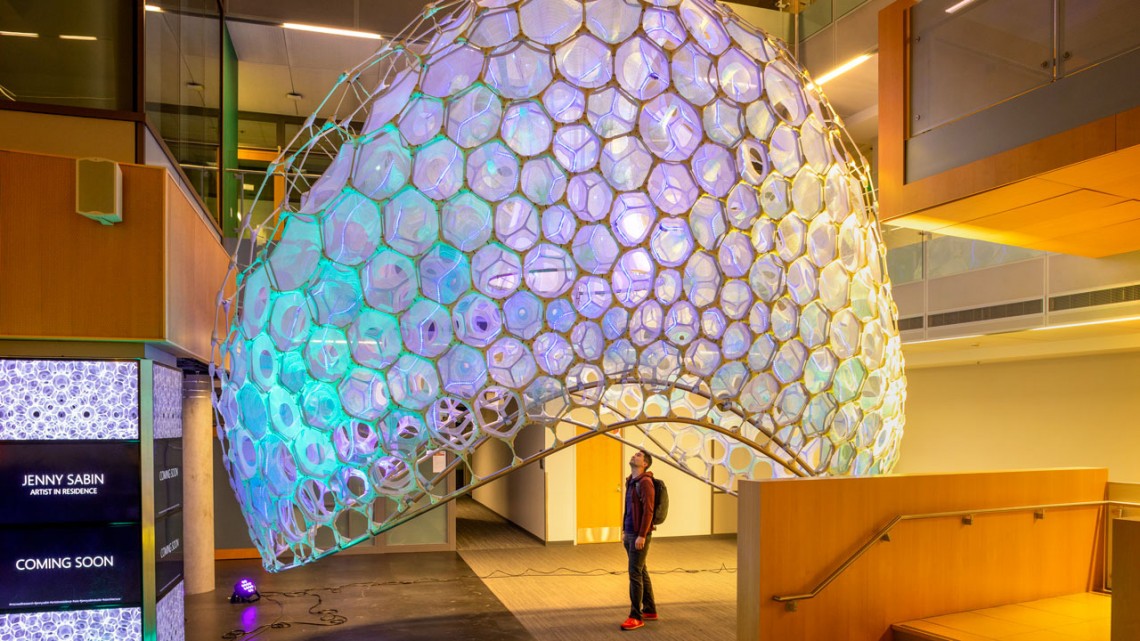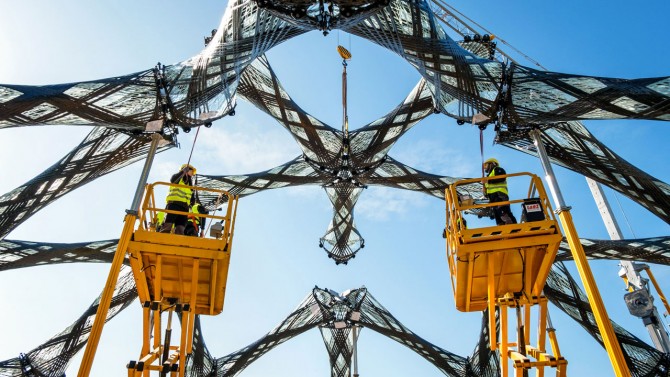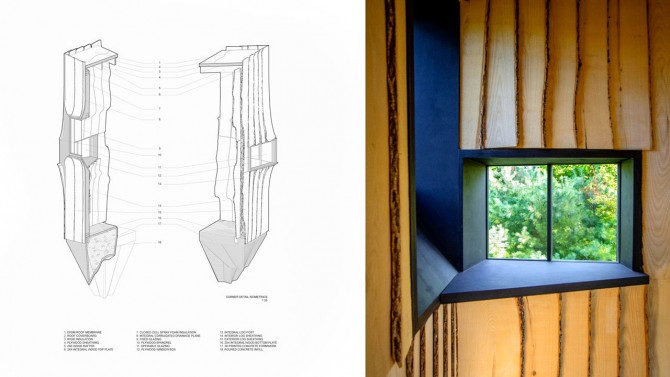
Ada, designed and built by Jenny Sabin Studio for Microsoft Research’s Artist in Residence Program, on Microsoft’s Redmond, Washington campus.
AAP faculty explore design innovation, resilience
By Melanie Lefkowitz
Faculty from the College of Architecture, Art and Planning (AAP) explored resilient architecture – design, engineering and construction that address climate change and other challenges – through technological innovation and from multiple perspectives at FABRICATE 2020, an online conference co-hosted Sept. 9-12 by AAP, Swinburne University in Melbourne and the Bartlett School of Architecture in London.
The conference’s theme took on greater significance amid the vulnerabilities exposed by the COVID-19 pandemic, as architects seek out design-driven technology innovations that can help communities thrive in a changing world.
“As active educators and researchers with connections to industry and practice, we discussed and debated urgent new models to make real impact in practice and to potentially change the construction industry and the making of buildings,” said Jenny Sabin, the Arthur L. and Isabel B. Wiesenberger Professor of Architecture.
Sabin co-chaired the virtual conference with Jane Burry, professor and dean of design at Swinburne University of Technology in Melbourne, Australia – the first time the conference has been led by two women since its inception in 2011.
More than 3,300 attendees from 100 countries participated in FABRICATE, which included presentations, webinars, live panel discussions and keynote speeches. Each day focused on a different topic: bio-materiality; synthesizing design and production; optimization for a changing world; and polemical performative practice.
“The ability for systems to absorb, adapt and recover is typically how we think of resilience, and today, many months into the global pandemic, resilience is also associated with the ability to cope and endure a crisis,” said Meejin Yoon, B.Arch ’95, the Gale and Ira Drukier Dean of AAP, in her keynote address on Day 4 of the conference, on the topic of polemical performative practice.
In addressing cultural and social resiliency through architecture, Yoon described the recently completed Memorial to Enslaved Laborers on the University of Virginia campus, designed by a team led by Höweler + Yoon Architecture LLP, in collaboration with architect and scholar Mabel O. Wilson, cofounder of Studio &; and artist Eto Ottigbe.
“The memorial, in addition to honoring and memorializing the lives of the enslaved, also creates a space to understand that history is still active,” Yoon said. “By tying the past to the present, it provides a much-needed space for active engagement with the legacy of slavery and systemic racism, learning from the past to create a more resilient, equitable and just tomorrow.”
The 20 presentations, chosen from hundreds of submissions, included “Embedded Architecture: Ada: Driven by Humans, Powered by AI,” co-authored by Sabin, John Hilla, visiting critic Dillon Pranger, M.Arch. ’15, Clayton Binkley and Jeremy Bilotti, B.Arch. ’18. “Ada,” a responsive, photoluminescent fiber pavilion which appears to smile back at viewers, was created by a team led by Sabin and including William Qian, B.Arch. ’19, and installed in an atrium at Microsoft Research in Redmond, Washington as part of its Artist in Residence program.
“An important aim of ‘Ada’ was to inspire and expand human engagement with each other and their environments,” Sabin said. “While AI powers the project by precisely narrowing and averaging statistical data, collected from individual and collective facial patterns and voice tones, the architecture of Ada augments through aesthetic experience, opening up the range of possible human emotional engagements through difference.”
Also presented was “Making Form Work – Experiments Along the Grain of Concrete and Timber,” by Leslie Lok and Sasa Zivkovic, assistant professors of architecture and co-principals at HANNAH, an Ithaca-based experimental design and research practice. The paper described the Ashen Cabin, designed and fabricated by Lok and Zivkovic using wood from trees killed by the invasive emerald ash borer, cut in a robotics lab, that would otherwise be unfit for traditional lumber processing.
“We were working with non-standard material for a while until we came across the emerald ash borer problem, which made our work more urgent,” Zivkovic said during a Q&A session on Day 2 of the conference. “And it made us wonder how resources we’ve developed can begin to address some of these large ecological and environmental crises. And so I do think that we can also actively search and look for these opportunities to further broaden the application of some of these methods in the field.”
With Bob Sheil, director of technology and computing at the Bartlett School of Architecture, University College London (UCL), and architect Marilena Skavara, Sabin and Burry co-edited the conference’s companion publication, “FABRICATE 2020: Making Resilient Architecture,” which includes 12 peer-reviewed papers in addition to the 20 presented at the conference. The book is available for free download.
The event, originally intended to be held in person over two days at UCL, was hosted by the Bartlett School of Architecture at UCL and UCL Engineering and co-organized by AAP and the Swinburne University of Technology. When FABRICATE switched to an online format, Cornell provided a virtual platform for streaming, expanding the conference’s reach to a broader audience.
Media Contact
Get Cornell news delivered right to your inbox.
Subscribe


